Fragile beauty
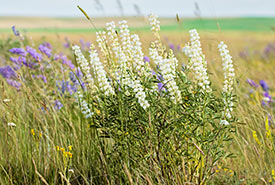
White silky lupine flower (Photo by Leta Pezderic/NCC staff)
The richness and diversity of some of Canada’s prairie plant species are at risk.
If variety is the spice of life, then grasslands are like a chef’s palette. Canada’s Prairie grasslands are home to dozens of species at risk. Iconic wildlife like burrowing owl, greater sage-grouse and swift fox are found here, as well as several fascinating and beautiful at-risk plant species.
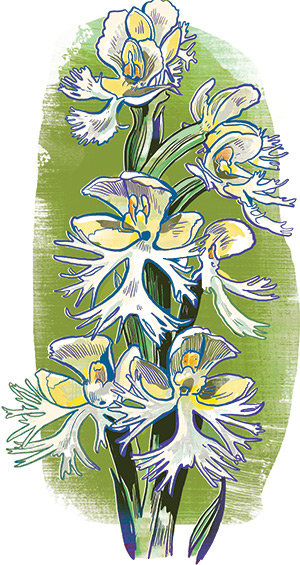
Platanthère blanchâtre de l’Ouest (Illustration de Jacqui Oakley)
Grassland areas themselves are diverse. Sand dunes, badlands and wetlands intersperse areas of grassy habitats, and each creates its own micro habitat. They also contain hundreds of types of plant species, including mosses, herbaceous plants and shrubs. These species epitomize the incredible variety of plant life found across the Canadian Prairies — from the fescue grasslands of Alberta’s foothills, to the tall grass prairie of Manitoba and the mixed-grass prairies in between. Sometimes this diversity is obvious — like when the flowering lupines, balsamroots and paintbrush cover the foothills in purple, yellow and red. At other times, it takes a hand lens and a discerning eye to appreciate. Whether common or rare, these plants benefit both people and ecosystems. Many flowering plants support pollinators, while others fertilize the soil by converting nitrogen in the air to forms that are usable by other species. Despite their importance, some of these grassland plants are now at risk. Some are naturally rare or have a limited range in Canada. Others are dwindling as more and more Prairie grasslands are lost or invaded by exotic species. The following are some of the at-risk plant species that you are helping protect by conserving Canada’s Prairie grasslands. The plants thank you, and so do we.
Western prairie-fringed orchid
When you hear the word orchid, you can’t help but picture something stunning, and the western prairie white-fringed orchid is no exception. This gorgeous, white-flowered plant found in Manitoba’s tall grass prairie grows in wet, calcium-rich prairies and meadows. Manitoba’s population of this endangered species, which includes half of its global population, is the northernmost of its range. A perennial species, western prairie white-fringed orchid can reach heights of 40 to 90 centimetres, and attains peak bloom from late June to mid-July.
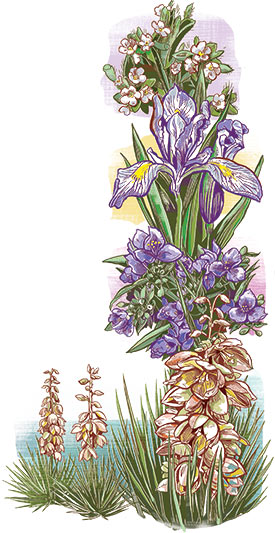
Haut en bas : Cryptanthe minuscule, iris du Missouri, tradescantie de l’Ouest et yucca glauque (Illustration de Jacqui Oakley)
Tiny Cryptantha
Found in river valleys in southeastern Alberta and southwestern Saskatchewan, this small, hairy plant has tiny white flowers with yellow centres. Canadian populations of this threatened species, which is also known as little cat’s-eye, are separate from the rest of its population, with the closest being about 200 kilometres to the south in Montana. Found in sandy upland areas and sand dunes, tiny Cryptantha is threatened by habitat loss and degradation.
Western blue flag
A native iris, western blue flag is a federal species of special concern found in Alberta. Its sword-shaped leaves produce stalks with two to four pale- to deep-blue flowers. It most commonly grows in the transition area between grassland and streamside habitat. A primary threat facing western blue flag is competition from invasive species.
Western spiderwort
This threatened plant is found on sand dune ridges, typically those that are steeper and south-facing. It has been observed at a handful of sites in southeastern Alberta, southern Saskatchewan and southwestern Manitoba. Blink and you might miss it; western spiderwort blooms from May to July, with each of its eye-catching purple-blue flowers lasting for only a single day. This plant is pollinated mainly by sweat bees.
Soapweed
Also widely known by its genus name, yucca, this threatened plant is found on coulee slopes in southern Alberta and Saskatchewan. It has stiff, pointed leaves and a group of creamy-white flowers that emerge from a flower stalk that grows up to 100 centimetres tall. Soapweed supports several specialized moth species, which are endangered in Canada.
Small white lady’s-slipper
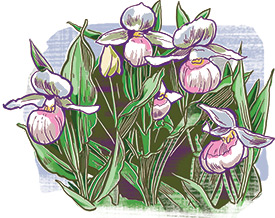
Small white lady's-slipper (Illustration by Jacqui Oakley)
Found in the tall grass and mixed-grass prairie of Manitoba, small white lady’s-slipper generally lives in areas affected by natural disturbances, such as wildfires, light grazing and mowing. Without these disturbances, tall vegetation and woody plants will outcompete these tiny orchids.
Small white lady’s-slipper is named, aptly, after its slipper-shaped flower, which blooms from May through June.
Hare-footed locoweed
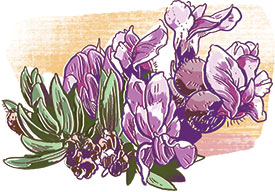
Hare-footed locoweed (Illustration by Jacqui Oakley)
A threatened member of the pea family, hare-footed locoweed is found in the fescue grasslands of southern Alberta. The first part of this species’ name refers to the fuzzy outer part of the flower, which some think looks like a rabbit’s foot. This low-growing, purple-flowered plant is being threatened by habitat loss and competition from invasive species, particularly crested wheatgrass.
This story originally appeared in the summer 2023 issue of the Nature Conservancy of Canada Magazine. To learn more about how you can receive the magazine, click here.




